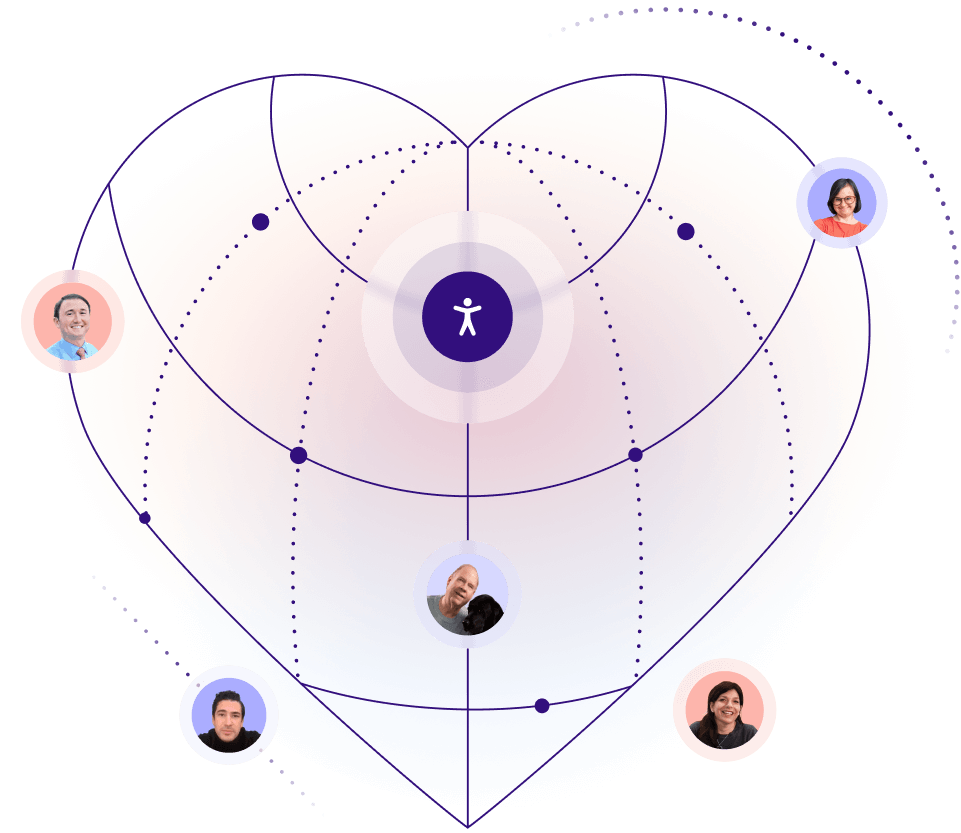Inclusivity is the practice of accepting and valuing people regardless of their differences. While inclusivity typically involves establishing a sense of safety and belonging for people in the workplace, it has expanded to include online spaces. Online inclusivity implies that a website, along with the documents, videos, and other digital assets featured within it, are designed in a way that offers everyone an equal user experience. It is important to note that inclusivity is more correctly referred to in the disability communities as "inclusion".
Inclusivity in web design
Inclusivity in web design involves strategically designing websites so that their appearance, layout, and resources are friendly to all users, regardless of location, language, education level, background, beliefs, or abilities.
An inclusive website is one that’s accessible to everyone. Companies can build accessible websites by adhering to the Web Content Accessibility Guidelines (WCAG). Created by the World Wide Web Consortium (W3C), WCAG is considered by many to be the most important protocol impacting global web accessibility policy.
WCAG accounts for various disability categories, including, but not limited to, cognitive, vision, motor, and audible impairments. Conforming to WCAG entails addressing a number of elements within your website so that they can be accessed by people who have these disabilities.
Some elements that may need to be addressed include, but aren’t limited to:
- Ensuring compatibility with screen reader technology
- Adding alt text to meaningful images
- Adding captions to videos
- Ensuring visitors can navigate by keyboard alone
- Ensuring sufficient color contrast between text and its background
The importance of inclusivity in web design
The importance of inclusivity in web design stems from the increasing demand for universal web accessibility. 16% of the world’s population has some type of disability. The disability community deserves equal access to websites and online services. By emphasizing inclusivity, companies can reach a wider audience, improve brand reputation, drive business growth, and increase sales.
A number of key anti-discrimination laws, including the Americans with Disabilities Act (ADA), are now applied to the online domain. Websites that are found to feature non-inclusive elements and layouts place their owners at risk of facing legal recourse. This includes being sent ADA compliance demand letters by individuals or groups, and potentially facing ADA website compliance lawsuits.
Inclusive web design best practices
Some best practices companies and individuals can incorporate to ensure their websites are more inclusive for all visitors include, but aren’t limited to:
Designing for accessibility
Accessible and inclusive design entails configuring design features to allow a person with disabilities to interact with a website. These can include properly labeling buttons and links, and ensuring text and its background color sufficiently-contrast.
Providing alternative content
Providing alternative content options allows people with specific disabilities to properly access them. Adding alternative (alt) text to meaningful images will enable those with vision impairments to understand them through braille displays or screen reader technology. Similarly, providing captions and transcriptions for videos will enable people with hearing impairments to access them.
Navigation and interactivity
Easy and intuitive navigation provides website visitors with disabilities a more inclusive user experience. To that end, websites should feature and incorporate the following elements:
- Alternate methods of navigating the website, such as a sitemap with valid links
- Clearly worded headings and labels
- Well-designed heading structure
Common barriers to inclusivity in websites
Currently, the vast majority of websites are partially or fully inaccessible to the disability community. This current situation is the result of a number of factors. These include, but aren’t limited to:
Lack of awareness and education among web developers
Web developers unaware of the need to account for people with disabilities may unintentionally develop inaccessible websites and products. Companies and organizations that value inclusivity can benefit from exposing web developers to relevant web accessibility standards, and help them gain expertise in accessible web development.
Technical limitations and resource constraints
Limited resources can result in the failure to meet inclusive web design requirements. Planning and structuring budgetary allotments with inclusivity in mind can help organizations remove digital barriers preventing people with disabilities from accessing their products and services.
Inadequate testing and evaluation of websites
Whether a website is sufficiently inclusive is not always apparent, especially to those with limited technical prowess or to those who are unaware of web accessibility standards and best practices. Websites can be audited for accessibility, either manually, or by using an automated web accessibility testing tool, or ideally by combining both. Once one gains an understanding of their website’s level of accessibility, they can then take the necessary steps to bridge accessibility gaps, if any exist.
Neglecting user feedback
By ignoring user feedback, website owners risk fueling ongoing problems that people with disabilities encounter. Offering simple ways to report positive or negative feedback, ask for assistance, or make suggestions enables business owners to be aware of all potential website issues. By providing different feedback options throughout the website, such as email, chat, or phone support, companies can ensure they’re meeting all their users’ online needs. Needless to say, website owners and administrators will need to act upon said feedback, and remediate existing accessibility issues that are reported.
Incomplete implementation of accessibility standards
Partial implementation of accessibility standards can limit the services, content, and products that people with disabilities will be able to use.
Failure to maintain accessibility over time
Accessibility legislation and standards evolve to fit contemporary trends and technological advancements. Ensuring websites are accessible and inclusive is therefore an ongoing process. Those who do not stay informed regarding new standards can find themselves failing to provide an optimal user experience to the disability community. It is important to note that changes and additions made to a website will need to be made with users and visitors with disabilities in mind. Otherwise, members of the disability community will be met with digital barriers that will limit their ability to fully access your website.

